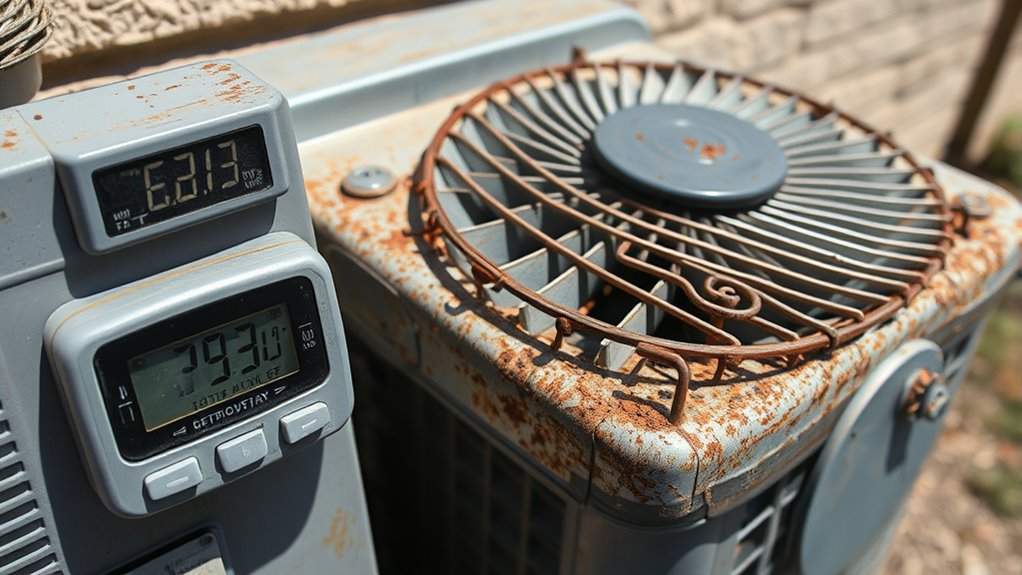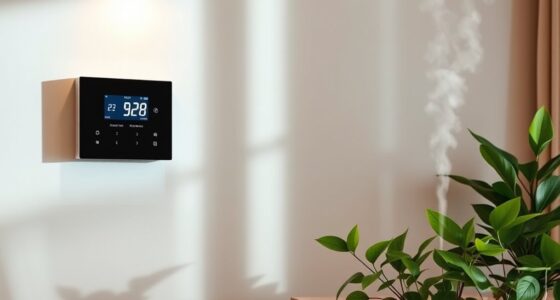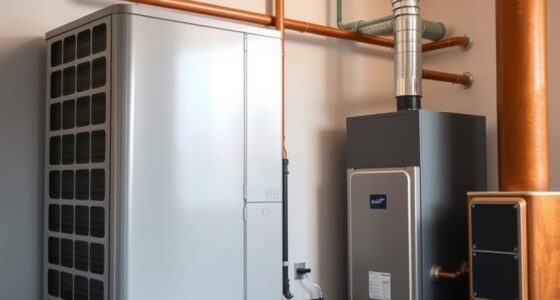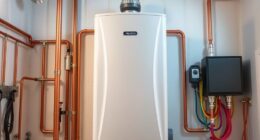If your air conditioner is over 10-15 years old, it’s likely time for a replacement, especially if it’s using more energy or needing frequent repairs. Signs like inconsistent cooling, strange noises, or unpleasant odors also point to aging or malfunction. Higher utility bills and poor comfort further suggest your system isn’t performing well. Keep an eye on these signs to avoid unexpected breakdowns—and discover more helpful tips as you explore options.
Key Takeaways
- Your AC is over 10-15 years old and shows signs of decreased efficiency or frequent breakdowns.
- Rising energy bills indicate the unit is working harder and less effectively.
- Inconsistent cooling, fluctuating temperatures, or comfort issues suggest it’s time for replacement.
- Unusual noises, odors, or ongoing repairs signal system deterioration and potential failure.
- The long-term savings from a new, energy-efficient model outweigh the costs of ongoing repairs.

Knowing when to replace your air conditioner can save you money and prevent discomfort during the hottest months. If your system is struggling to keep your home cool or is suddenly using more energy than usual, it’s time to pay closer attention. An aging AC unit often becomes less energy efficient, meaning it has to work harder and consume more electricity to do the same job. This increased energy usage not only hikes up your utility bills but also signals that your system may be nearing the end of its lifespan. When considering replacement costs, it’s essential to weigh how much you’re spending on repairs and energy bills versus investing in a new, more efficient model. Additionally, understanding the typical air conditioner lifespan can help you determine whether it’s time for an upgrade.
Replacing an aging AC saves energy, reduces bills, and prevents discomfort during summer heat.
Typically, air conditioners last around 10 to 15 years, but that lifespan can vary depending on usage, maintenance, and brand quality. If your AC is pushing past this age, it’s more prone to breakdowns and less likely to operate at peak energy efficiency. Frequent repairs, such as replacing compressors or refrigerant leaks, can add up quickly and often point to the need for a new system. Although a new unit involves an upfront investment, it can lead to significant savings in energy bills over time thanks to modern technology that prioritizes efficiency.
Another clear sign that it’s time for a replacement is inconsistent cooling. If your home feels warm in certain rooms or the temperature fluctuates wildly, your current system might be struggling to distribute air evenly or may no longer have the capacity to handle your home’s size. This inefficiency not only causes discomfort but also forces your AC to run longer, increasing energy consumption and wear on the unit. Additionally, if your AC makes strange noises, produces unpleasant odors, or requires frequent repairs, these are signs that the equipment is deteriorating beyond simple fixes. In such cases, replacement costs might be justified by the reduced maintenance and improved efficiency you’ll enjoy with a new system.
Ultimately, investing in a new air conditioner can be a smart decision if your current unit is old, inefficient, or frequently breaking down. It ensures you stay comfortable during the hottest months while saving money on energy bills. By paying attention to these signs, you can make an informed choice that balances upfront replacement costs with long-term savings, comfort, and peace of mind.
Frequently Asked Questions
How Long Does a Typical Air Conditioner Last?
A typical air conditioner lasts about 10 to 15 years if you follow proper maintenance tips. Regularly cleaning or replacing filters, checking refrigerant levels, and scheduling annual professional checkups help maintain cooling efficiency. Over time, parts wear out, and efficiency drops, signaling it’s time to think about replacement. Keeping up with maintenance ensures your AC runs smoothly and prolongs its lifespan, saving you money and avoiding unexpected breakdowns.
Can I Repair My AC Instead of Replacing It?
Think of your AC as a trusted car—sometimes a repair can breathe new life into it. You can explore repair options, but consider the cost comparison; if repairs cost almost as much as a new unit, it’s like patching a sinking ship. Small issues like minor leaks or filter replacements are worth fixing, but if frequent breakdowns happen, replacing might save you from ongoing headaches—and expenses—down the road.
What Are the Energy Savings With a New AC?
A new AC can notably boost your energy efficiency, leading to considerable cost savings on your utility bills. Modern units are designed to consume less power while maintaining ideal cooling performance. By upgrading, you’ll reduce energy waste, lower your environmental impact, and save money over time. Over the lifespan of a new system, these energy savings can offset the initial investment, making replacement a smart choice for long-term comfort and financial benefits.
How Much Does a New AC Installation Cost?
A new AC installation costs between $3,000 and $7,000, depending on the unit type and your home’s size. You’ll want to compare costs during the installation process, which includes removing your old unit, preparing the space, and installing the new system. Factors like brand, efficiency, and added features influence the total price. Getting quotes from local HVAC professionals helps you make an informed cost comparison.
Are New AC Models More Environmentally Friendly?
Back in the day, AC units were less eco-friendly, but today’s models use advanced, eco-friendly technology. New AC models are more environmentally friendly because of refrigerant improvements that reduce ozone depletion and greenhouse gases. These upgrades help you lower your carbon footprint while maintaining cooling efficiency. So, if you’re considering an upgrade, modern units are a smart choice for both performance and environmental impact, making your home greener and more sustainable.
Conclusion
Knowing when to replace your air conditioner can save you money and prevent discomfort. If your unit is over 10-15 years old or requires frequent repairs, it’s probably time for an upgrade. Did you know that an aging AC can increase energy bills by up to 30%? By paying attention to signs like inconsistent cooling or strange noises, you can guarantee your home stays comfortable and your energy costs stay manageable. Don’t wait until it’s too late—act now!








